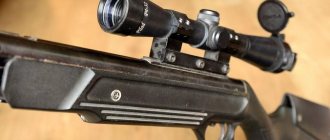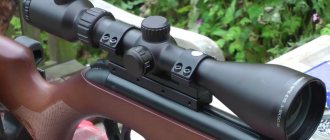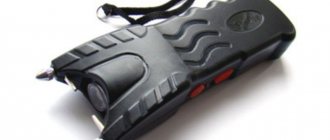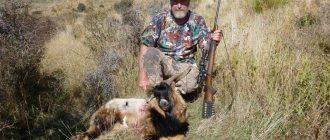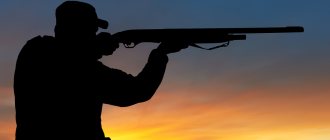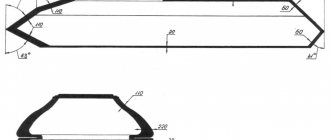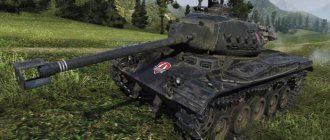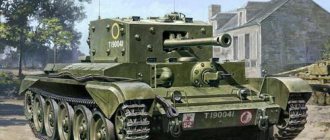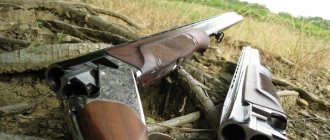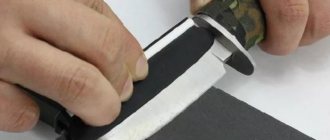- November 2, 2018
- Weapons and ammunition
- Michael
Probably every hunter has heard about the Simonov carbine - a reliable, simple and easy-to-use weapon. True, there is a belief among some that it is primarily suitable for those who like to hunt relatively small game. Let's figure out what kind of hunting with an SKS can bring maximum pleasure and adrenaline, and at the same time learn more about this formidable weapon.
A few words about SCS
To begin with, it is worth noting that the SKS was initially developed for the needs of the army and it was in service for some time - from the late 40s, and in some branches of the military - until the end of the 80s. For a long time it was the same standard weapon as the Degtyarev machine gun and the Kalashnikov assault rifle of the 1947 model. Each weapon had certain advantages and purposes.
However, over time, the SKS was removed from service due to the low rate of fire (there was no automatic fire mode, unlike the AK) and inconvenient loading - with clips with an integral magazine.
Tens of millions of high-quality weapons could remain in warehouses. But it was decided to modify them a little (more on this a little later), and then give the opportunity to purchase them to ordinary hunters - primarily fishermen. Thus began the second life of the carbine - not military, but hunting. It is worth noting that reviews of hunting with the SKS are mostly positive, so we can say with confidence that it copes with its task perfectly.
Story
The initiator of the creation of the SKS in the form in which we know it was the appearance in 1943 of the intermediate cartridge 7.62x39 (7.62x41 in the first batches), and the beginning of the mass development of weapons for the new platform. Experienced gunsmith Sergei Gavrilovich Simonov, after failure with a version of the carbine chambered for the 7.62x54 rifle cartridge, undertook to adapt his developments to the new cartridge, and by 1944 prototypes of the SKS entered testing.
Reviews about the weapon were contradictory: those of the carbines that were sent to the officer retraining course “Vystrel” performed well, while the small batch that went to be tested in units of the 1st Belorussian Front was criticized. Soldiers complained about delays from sticking and non-ejection of cartridges, which were aggravated when the weapon became contaminated. As a result, the weapon was sent for modification and correction of problems - I did not want to completely abandon such a light, accurate and maneuverable carbine.
Taking into account all the wishes, Sergei Gavrilovich corrected all the shortcomings before 1948, and already in 1949 the SKS chambered for 7.62x39 entered service in the Red Army, where it served until the early 60s, when all small arms everywhere began to be replaced by AKM . After that, until the 90s, the SKS was in service with the rear and security units, and is still used as a ceremonial weapon - due to its light weight and good balance, it is easy for them to perform various elements of combat techniques.
The rather unprepossessing history of service in Russia, the SKS carbine is fully compensated by its enormous popularity in the world, being the same well-known and recognizable weapon as the AK. It is still in service with more than 30 countries, and has seen action in conflicts ranging from the Korean War to the more recent Syrian conflict. The most surprising thing is that the SKS is most popular in the USA, where the number of its owners significantly exceeds that in Russia, and there is also a very rich market for tuning and accessories for these weapons.
It won’t be difficult for you to make something similar from your SCS
Why did the hunters like him?
The important advantages of the carbine can be listed for a long time. First of all, these are small dimensions - the length of the weapon is only 1 meter. Quite a bit for a reliable hunting barrel. At the same time, the loaded weapon weighs only 3.9 kilograms - a very good indicator. But still, it remains a rifled weapon, which allows even the least experienced hunter, without the use of an optical sight, to confidently hit a target at a distance of 200-300 meters.
But the carbine was developed for the needs of the army, which means it is reliable. Indeed, the minimum number of grooves and moving parts almost completely eliminate the possibility of the weapon failing. And this is exactly what every hunter needs.
The low rate of fire is no longer a disadvantage. Still, when hunting with an SKS, no one would think of shooting in bursts. And the not very convenient reloading has ceased to cause inconvenience. 10 rounds of ammunition in the magazine is quite sufficient ammunition even when hunting wild boar, elk or bear. Yes, and you obviously won’t have to reload an empty magazine under enemy fire, like soldiers and officers - you can do it slowly, at a parking spot, or simply after any shot.
Rifled versions
Among the rifled versions of the SKS there is a larger assortment, but the versions differ slightly from each other - these are still the same fenced army carbines with minimal changes.
TOZ KO-SKS
Carbine TOZ KO-SKS RT 7.62x39 18,750 ₽
Carbine TOZ KO-SKS RT 7.62x39
Licensed product Large-sized Not delivered by TC
Notify about arrival
A rifled version of the SKS carbine from the Tula Arms Plant. It is distinguished by minimal interventions in the design and appearance - even the stock remains unchanged, covered with the same cherry varnish. Suitable for lovers of authentic weapons and collectors. In addition to its pristine appearance, the SKS from Tula is also the most affordable of all versions.
ZID SKS-O
Carbine ZID M-Armz SKS-O 7.62x39 with coating 26,499 ₽
Carbine ZID M-Armz SKS-O 7.62x39 with coating
Licensed product Not delivered to TC
Notify about arrival
The fencing of these carbines takes place at the Degtyarev Plant, for the Molot-Arms company. The metal parts and stock are processed, painted and coated with modern protective agents such as nigrosin, so this SKS has a much neater appearance. There is a riveted side rail for the sight.
Hammer OP SKS
Carbine Hammer OP SKS 7.62×39 520mm 30,539 ₽
Carbine Hammer OP SKS 7.62×39 520mm
Licensed product Large-sized Not delivered by TC
Add to cart
The Hammer fence is the least forgiving, but its appearance is more presentable. The bluing on most parts is sanded off, the coating is replaced with nigrozin and similar paints. The stock is sanded and varnished, and in some batches new stocks are installed. A rail for sighting devices is also installed.
This version is suitable for those who want to shoot with an optical sight - you don’t have to add anything to do this.
Pin in the SKS barrel
According to existing GOSTs, new-made rifled weapons must differ in the nature of the rifling from army weapons, for which purpose they are made differently in shape. This change does not affect the ballistic characteristics, but allows you to determine from the bullet which weapon the shot was fired from.
But in the case of SKS, which were fenced without re-barrel, the situation is a little more complicated - in such weapons they usually make a hole in the base of the barrel and weld a pin into it, which acts as a crimson mark.
Of course, any such changes do not add accuracy to the weapon or strength to the design. However, there is debate about the degree of influence on accuracy, and most shooters agree that if there is an influence, it is insignificant.
In any case, if you somehow manage to find an SKS made before 1993, when they began to be pinned en masse, during re-registration you will be very persistently asked to give the weapon for pinning, and in this case it may turn out to be much less gentle than the factory one.
Pin in threaded versions SKS externally and internally
Advantages and disadvantages
Advantages of the SKS rifled carbine:
- A very affordable weapon with a low cost per shot.
- Accuracy is superior to weapons on the AK platform and approaches those of the SVD platform.
- Convenient balance of the weapon, which makes the weight feel much less.
- Easy to maintain, unpretentious and omnivorous automation.
- Rich possibilities for tuning.
Minuses:
- The degree of fencing changes may vary from batch to batch, regardless of manufacturer - weapons must be selected upon purchase.
- In the basic version, out of the box it is an archaic carbine, which requires investment in tuning.
- For running hunting, there are better options that are lightweight and practical.
What kind of prey is it suitable for?
Most often, most experts associate hunting with an SKS carbine with relatively small animals (hare, sable) and large birds (grouse grouse). Needless to say, the carbine is perfect for such production. On the one hand, it hits over a huge distance. On the other hand, you don’t have to spit shot when eating game caught with the help of an SCS, in contrast to cases when hunting is carried out using a smooth-bore weapon. In this case, the skin is practically not damaged - one small inlet hole and the same outlet.
A particularly important advantage is range. If in order to make a good shot from a smooth-bore weapon, you need to get to a distance of 30-40 meters, then from a rifled carbine you can confidently place a bullet at a distance 2-3 times greater.
Well, experienced shooters often take the SKS to hunt larger animals - wild boar, elk and even bear. Of course, hunting becomes very dangerous: a wounded bear is not a wounded hare at all! You can instantly kill a large animal only by hitting several points - the head (and not just any place!), the heart, or at least the spine. Such a shot, and even at a long distance, is only possible for a very good shooter. But even they rarely go hunting for such dangerous prey alone. Often they are backed up by less experienced shooters armed with smoothbore weapons in order to fire a finishing shot if necessary.
Speed
Write down for yourself the minimum you need. Despite the stories of marketers, 10 megabits is enough for most modern applications. A rare application needs 100 megabits (mainly due to pumping a large amount of data). If the application needs gigabit, then perhaps you have made a mistake with the installation location (maybe it’s better to be closer to the servers?). Write down everything that is usually done on the computer. It turns out that most of these tasks are not at all demanding on speed. If you haven’t found such applications, then the technical specification clearly states a requirement of category 5e, and not 6, as they may try to persuade you to do.
What is OP SKS
As mentioned above, before selling the SKS to private hands, the weapon is altered in a certain way. The simplest modification option was called OP (hunting and commercial) SKS.
It is practically no different from the basic version. There are only two differences. Firstly, the mount for installing the bayonet was removed - it is completely unnecessary for hunting; it would hardly occur to anyone to run into an attack on a wounded bear, using a weapon like a spear. Secondly, the aiming bar is limited to 300 meters. Well, the vast majority of hunters don't have to shoot long range with open sights. So when hunting with OP SKS, this range is quite enough. Those who like to shoot at long distances usually install additional sights.
Design
The Simonov self-loading carbine consists of the following parts and mechanisms:
- barrel with receiver, bayonet and sights,
- receiver cover;
- gate;
- return mechanism;
- gas tube with receiver lining;
- gas piston;
- pusher with spring;
- trigger mechanism;
- shop;
- box.
A clip is used to quickly fill the integral 10-round magazine. To use the clip, there are special guides on the bolt frame. When the cartridges are used up, when the magazine is empty, after the last shot, the bolt goes into a slide stop, which reduces the time for subsequent replenishment of the magazine with cartridges.
SKS sights consist of a sight and a front sight. The sight, in turn, consists of a sight block with a leaf spring, an aiming bar and a clamp with latches and springs. The sight block has two sectors to give the aiming bar a certain height. On the bar there is a scale with divisions from 1 to 10 (indicating the firing range in hundreds of meters) and the letter “P” (permanent sight setting, corresponding to sight 3).
The bayonet is a bladed, permanently folding one, consisting of a blade with a base and a tube with a spring (providing shock absorption of the bayonet for uniform SKS combat, regardless of the position of the bayonet). Some early Simonov self-loading carbines had a needle bayonet.
The SKS kit includes: accessories (cleaning rod, cleaning rod, brush, drift, pencil case and oil can), belt, cartridge bags and clips.
Reloading of the SKS after the next shot is carried out automatically, for which the energy of the powder gases removed from the barrel is used. The barrel bore is locked by tilting the bolt downwards. The barrel is black forged, not chrome plated.
A little about the Lancaster SCS
A more interesting modification is the Lancaster. In fact, this is a completely new weapon based on the old one. But still, reviews from owners of the Lancaster SCS from hunting are mostly positive.
The conventional 7.62 mm rifled carbine is equipped with a new barrel suitable for use with .366 TKM cartridges. That is, the weapon is already smooth-bore, which means it can be purchased by hunters who do not have 5 years of experience and the relevant documents, which are much more difficult to obtain. At the same time, a modern cartridge allows you to confidently place a bullet at a distance that is prohibitive for a smooth-bore weapon. So hunting with the SKS-366 Lancaster is almost always successful, especially if a sufficiently experienced shooter is working with it.
The tide for installing a bayonet-knife is not sawed off, thanks to which the hunter can get a truly formidable weapon without spending extra time on paperwork for rifled weapons and even without having the appropriate experience.
Disassembly, assembly and maintenance
Partial disassembly of the SCS is carried out for cleaning, lubrication and inspection in the following order:
- removing the pencil case with accessories from the butt;
- cleaning rod compartment;
- separation of the receiver cover;
- removing the return mechanism;
- removing the shutter;
- separation of the frame from the bolt stem;
- separation of the gas tube with the barrel lining.
Reassembly after partial disassembly is carried out in the reverse order.
Complete disassembly of the Simonov self-loading carbine is carried out for cleaning in case of heavy contamination, after exposure to rain or snow, when switching to a new lubricant and repair in the following order:
- incomplete disassembly;
- removing the pusher with the spring;
- firing mechanism compartment;
- store branch;
- separation of the barrel with the receiver from the stock;
- disassembling the trigger mechanism;
- disassembling the return mechanism;
- separation of the firing pin and ejector from the bolt body.
Reassembly after complete disassembly is carried out in the reverse order.
It is recommended to use gun lubricant and alkaline composition (to remove powder deposits) in summer (at temperatures above 5 °C), and in winter (from +5 °C to −50 °C) to use liquid gun lubricant (for lubrication and removal of deposits) , carefully removing (by washing all metal parts in kerosene or liquid gun lubricant, thoroughly wiping with a rag or tow, then rinsing again and wiping with a clean rag) before doing this the summer lubricant. For long-term storage, the carbine is generously lubricated with a mixture of 50% gun lube and 50% gun lube by dipping the cleaned metal parts twice into baths of hot lube.
Do you need optics?
This is a rather complex issue that causes a lot of controversy among experienced hunters. Some shooters believe that optics are not needed only when hunting with the Lancaster SKS, but in other cases they are necessary. They explain this by saying that only with a good optical sight can the full potential of the weapon be fully revealed. It’s hard to argue with this - the bullet maintains a stable trajectory at a distance of 400-500 meters. But without optics it is very difficult to hit the target at such a distance.
Other hunters are against optics. Some say that this is just unnecessary pampering - you can always damage expensive and fragile optics with a simple blow or fall. Others even consider such hunting unsporting - you need to shoot at a distance when you can clearly see the prey, which provides a higher probability of quick death.
So each SCS owner must make the final decision independently.
Tuning options
Another important advantage of SCS is its extensive tuning capabilities. If the owner is not too limited in funds, then on the basis of a simple carbine you can create a real work of art. Depending on the needs of the owner, the weapon can be modified in any way. Optical sights are installed, a bipod is installed, the stock and forend are changed, and instead of a fixed magazine, new ones with a larger capacity appear.
As a result of this modification, the weapon is simply no longer recognizable. At the same time, its reliability and simplicity do not suffer, of course, if the work is performed by experienced craftsmen. Yes, extensive tuning is quite expensive. But, according to the owners, every ruble spent is fully compensated by the increased ease of shooting.
A little about moose and bear hunting
These two animals are the most desirable trophies for any hunter. But they are also the most dangerous. One unsuccessful shot combined with ordinary failure can lead to the fact that the hunter will never return home or will remain disabled for life. Therefore, some hunters believe that the SKS is not suitable for hunting elk and bear. Additionally, this is confirmed by practice - inexperienced shooters, having fired a couple of shots at a huge animal and not putting it down, decide that a rifled cartridge of relatively low power is not suitable for hunting.
In fact, they are only partly right. In the hands of an inexperienced hunter, a carbine can really pose a danger to the shooter when hunting a large game. The SKS-366 Lancaster is better suited here - when hunting large animals, a more powerful cartridge with a heavy bullet is quite good.
But an experienced shooter will disagree. After all, a special chic among old-school hunters is the ability to kill an animal instantly, with one single shot, and even at a long distance. Of course, for this you need not only to shoot very well, but also to know the anatomy of the animal. For this purpose, special targets are used, according to which you can get used to choosing the most suitable place to shoot.
The first shot is especially important here. It must be lethal - it is no longer possible to place the second and subsequent bullets so accurately when shooting at a running animal. Therefore, experts try to finish off the beast immediately, hitting the head or heart.
Distribution in the world
During its service, Simonov's self-loading carbine managed to see battles during the Cold War. It was exported to African and Asian countries from the 50s to the 70s. In some cases, it was ahead of the SVD (Dragunov sniper rifle) in supply volumes.
The first serious test was the Korean War. The Vietnam War was the second step to confirm its advantages over other types of similar weapons. There, the SKS was armed with the most trained units of the Vietnamese army, because in the jungle it needed special care, although much less than American rifles.
Due to the use of the Simonov rifle in Vietnam, the Americans exported many captured carbines.
According to today's data, Simonov carbines of various modifications (including hunting ones) have been sold in America about three million units, counting from the Vietnam War to 2022.
Let's go from SKS to boar
Another desirable trophy is a wild boar. It has smaller size and, accordingly, endurance than an elk or a bear, but still the wounded animal also poses a huge danger to the hunter.
The best hunting cartridges for boar hunting are those with a bullet weighing 8 grams, made of three components: a steel core, a lead jacket and a bimetallic jacket. They are quite easy to identify - the lead head is clearly visible at the top of the bullet.
When fired at a distance of up to 300 meters, the bullet upon impact causes a huge shock due to deformation. This happens even when it hits soft tissue, and if there are bones in the way, the bullet simply crushes them, leading to additional stunning and increasing the chances of instant death of the animal.
Standard cartridges can also be used, but in this case the firing distance should be reduced to 200 meters. Still, the wild boar is a much more tenacious and hardy creature than the person against whom the cartridge and weapon were originally developed. Therefore, you need to shoot in certain areas - the spine, lung, heart, head. In this case, the animal dies almost instantly, does not suffer from pain, does not run away through the forest for several kilometers and does not pose a danger to the hunter.
